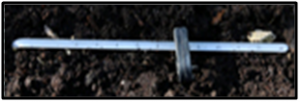Many early scientists recognized that air expands when heated and various names have been credited with its slow development. The first thermometer invented in Europe was created over 300 years ago by Galileo and was a simple open glass tube and a vessel of water. This was followed in about 1640 by the first sealed thermometer, allegedly by Ferdinand, Duke of Tuscany. This instrument is believed to be the first using alcohol to indicate temperature. Over the last few years, with the advance of electronics, many affordable, portable instruments have become available which are especially useful in that data can be recorded over a period of time. Since 2012, mercury-in-glass thermometers are being phased out due to the toxicity of mercury and being replaced by coloured alcohol thermometers.
 Wall Thermometer
Wall Thermometer
The most basic thermometer, which is found in most homes, is a simple wall thermometer. These units are very cheap and readily available. The single tube is attached to a backing plate composed of wood or plastic and measures the ambient or current air temperature. This is satisfactory if the only data required is a record of the air temperature at the time of viewing. It does not have the facility to record the highs and lows over a time period and due to its simple construction and modest cost is not particularly accurate. There is little space around the bulb for air to circulate freely.
Maximum and Minimum Glass Thermometer

One of the simplest and most economical of instruments is a maximum / minimum thermometer. This glass tube of double length, bent halfway to form two parallel columns will measure, as its name implies, the highest and lowest air temperature on a daily basis. Two indices or markers sit on top of the liquid in each column and as the temperature rises, the column of liquid rises up the right hand column and pushes up the marker. As the temperature drops when evening approaches, the marker on the left hand column is similarly pushed upwards. Both markers are designed to stay in place until reset. The highest and lowest temperatures can then be read from the base of the marker, which is then reset each day. The older instruments required the use of a magnet that was placed over the marker and it was then dragged downwards to the top of the liquid. Most current instruments have a small button set in the middle of the thermometer which when pressed and held will allow the marker to slowly drop down inside the column until it reaches the top of the liquid. This instrument is often used by gardeners to monitor greenhouse air temperature and sometimes referred to as a Six’s thermometer. The results are fairly accurate for a start-up weather station. Again, there is limited space around the bulb for air to circulate freely.
Circular Metal Maximum and Minimum Thermometer
A unit of very different design is circular in shape. It is a mercury free design and is activated by a bimetal temperature-sensing element. The two bands of different metal expand at dissimilar rates to operate the hands on the circular dial. Turning the button in the centre of the dial resets the instrument.
 Electronic Thermometer
Electronic Thermometer
Several electronic models have come onto the market over the last few years that have a monitor that provides a continuous readout. This monitor is convenient for indoor use as it utilises a sensor placed outside that either connects via a small cable or more usually wirelessly. Such instruments will provide daily maximum and minimum values.
Window Thermometer
There is an electronic unit that is supplied with a sucker in order for it to be attached to the outside of a window but able to be read from inside. However, its close proximity to the glass, which is affected by the room temperature, will mean that the results are not particularly accurate for measuring current outside air temperature. However, this might be a suitable instrument for children to use and initiate an interest in the weather and how it affects us as humans.
Individual Glass Thermometers
An enthusiast might wish to make the first purchase a more accurate instrument that could be placed inside a suitable container that shields it from the effects of the sun such as a Stevenson Screen (see chapter 10). These individual glass thermometers are designed to measure either the maximum or minimum temperature and come with a plastic or wooden backing enabling it to be placed outside. These need to be reset daily either as for the maxim by shaking the thermometer in order for the liquid to reach the bulb at the base or for the minimum to hold the bulb end up until the marker reaches the liquid inside the thermometer. A variation on this model is a similar glass thermometer that has no backing but is attached inside a screen, which is provided with suitable clip for retaining the instrument in the correct position. The thermometer would need to be detached from its fixing and held at an angle in order for the marker to slide back to the top of the liquid column when resetting daily.

Advanced Station

There is a big stepup between the instruments described above and the fully automated air temperature-sensing unit that comes combined with other instruments. It is a unit widely used for unattended sites and data is wirelessly transmitted to a monitor that stores data over a long period. The advantage of purchasing such a unit is that not only does it record and store much more data but it is always working, even when the amateur is on holiday so that no data is missed. The data is continuously displayed on the monitor which can then be interrogated for data stored from previous days, if absent for a while. Such stations are powered by a small solar panel attached to the unit so that it must be aligned carefully to obtain maximum solar power. Included within the unit is a small lithium battery that stores a small electrical charge to run the station when solar power is not obtainable, such as night time periods and especially during the long, dark days and nights of winter. There is the option of purchasing software for downloading to a computer from which the data it can be retrieved analysed and graphed (see later sections).
Soil Thermometer

A more specific need might be to record the temperature of the soil. In winter it will indicate to what depth any frost has permeated the soil thus giving a warning about damage to plants or equipment buried in the ground. As spring approaches the soil inevitably starts to warm up, this then gives an indication to gardeners when it is appropriate to sow various crops. These thermometers, usually constructed of glass, come in two quite different designs. The simplest unit is a straight glass tube that is available in differing lengths to record the soil temperature at varying depths. The reading from the straight unit is not easily obtained, as the scale is vertical and very close to the soil surface. An alternative and very different design is available that comes in the shape of a right angle. This latter thermometer is more easily read as the scale is horizontal to the sensing bulb but again comes in a selection of increasing lengths, usually starting with a bulb that measures temperature at a depth of 5cm.
 Wall Thermometer
Wall Thermometer Electronic Thermometer
Electronic Thermometer





